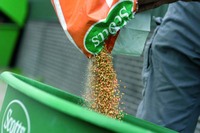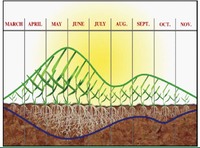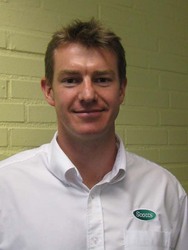In Part 2 of his ‘back to basics’ series on fertilisers, Scotts International Technical Manager, Stuart Staples, considers how understanding turf’s natural growth pattern can assist you in putting together the right fertiliser programme
It’s all in the timing
 An important aspect of managing sports turf is understanding how turf naturally grows through the season and what stresses it endures at different times of the year. If we can optimise turf growth and minimise the stresses it faces, you are half way there to producing a great playing surface.
An important aspect of managing sports turf is understanding how turf naturally grows through the season and what stresses it endures at different times of the year. If we can optimise turf growth and minimise the stresses it faces, you are half way there to producing a great playing surface.
In general, grasses grown in the UK (cool season grasses) all follow a very similar natural growth pattern. From spring until early summer there is the first growth peak of the year, followed by a slowing down of growth during the height of the summer; as temperatures cool in later summer/early autumn the second (smaller) growth peak occurs followed by a real slowing down in late autumn/winter when the grass goes into dormancy.
In order to achieve great sports turf we have to provide it with light, water and nutrients. There is little we can do about light levels, apart from redesigning stadia, moving geographic location or using lighting rigs. But there are now many tools available for managing turf nutrition.
The essential nutrients discussed in Part 1 need to be present in order for the plant to survive. There will be a certain reservoir of nutrients in the soil but, for the rest, they will need to be applied via fertiliser applications. In order to have a great performing sports surface you have to have grass that does more than just survive. It must be tolerant to the stress of demanding match schedules and resist wear and tear for the full duration of the playing season.
How to apply
The fertiliser industry recommends the following Best Management Practice:
• Right product – Select the right fertiliser for your application
• Right rate – Match the right fertiliser with crops and soil/growing media conditions
• Right time – Match the fertiliser availability with the crop demand
• Right place – Position the fertiliser near the plant for efficient use
In Part 1, we looked at the different types of fertilisers and how to calculate application rates. Now let’s look at timing.
Matching nutrient inputs according to growth phases
The nutritional requirements of a sports surface can be met if fertilisers are applied in certain ratios at particular times during the season. Fertiliser should be applied to match the natural growth pattern of grass (see diagram) while, at the same time, having an awareness of the other interactions such as climates, diseases, water resources and players!
Winter
In the middle of winter minimal nutritional inputs are required as the grass is likely to be in dormancy or growing very slowly. However, in milder winters when the turf is growing, some low level feeding will help maintain a healthy plant.
Nutrient inputs at this time of the year should be kept to a minimum using either:
• low application rate of liquids
• low analysis conventional fertilisers or
• slow release fertiliser that can only release nutrients when the conditions are suitable for turf growth
Using these types of fertilisers will help harden the turf and ensure there is no excess soft growth.
Very low nitrogen inputs are required during this growth stage whilst high potassium levels can enhance turf hardening. Use of iron containing fertiliser can help give a turf colour response without excess growth.
Spring
As turf comes out of its winter dormancy with the onset of spring, it is important to match this natural growth peak with appropriate fertiliser inputs.
A liquid fertiliser can be a good option as the first application of the season. When soil temperatures are low, liquids provide nutrients direct to the plant, bypassing the roots altogether. Certain nutrients such as phosphorus are actually unavailable when soil temperatures are low, so foliar feeding is essential.
Alternatively, a low nitrogen content granular product can give a good start in early spring without giving too much growth, at the same time hardening the turf at this early stage in the season.
As temperatures increase, an application of a high nitrogen NPK controlled-release fertiliser will ensure a healthy sports pitch during the main growth period. In general terms, the majority of the annual nitrogen application should be applied during this main growth peak.
As grass is naturally entering a growth peak, the nutrients removed in clippings need to be replaced. The steady delivery of nutrients from controlled-release fertilisers prevent a feast/famine cycle and encourage better rooting to help deal with the potential stresses of summer drought.
Controlled release fertilisers increase the efficiency of nutrient application. They don’t just promote better turf quality, but can also help reduce cost by reducing the number of applications required each season. One of the most cost effective fertilisers to apply nowadays is one that releases over 8-9 months. In terms of price per kg, this can appear to be expensive, also in terms of cost per application since it is applied at up to 60kg/Ha but, as only one application is required per season, it can be the most economical along with additional savings on labour time and costs. If this single application option is chosen (it is only suitable for winter sportsfield turf) then ignore the rest of this article!
Early summer
As temperatures increase through the summer, the pitch should receive sufficient nitrogen and potassium to maintain growth where possible and to help the plant store carbohydrates in its roots ready for upcoming stresses. The application of potassium during the summer, such as a 19:5:18 with three month longevity, enables the turf plant to better regulate water losses and so will help it cope with heat and drought stress.
If you maintain winter games pitches, this is the time of the year when end of season renovations take place. At this point, an over-seeding/renovation growth phase programme should be used as discussed later.
Late summer
As turf comes out of summer stress, it is important to provide adequate nitrogen to match the second (smaller) natural growth peak of the season. A balanced NPK fertiliser is ideal during this time to help aid recovery and replace nutrients lost in clippings whilst, at the same time, hardening turf ready for the autumn. If you use a controlled release fertiliser with a three month longevity in early summer as described above, sufficient nutrients will be delivered for this time of year as well.
Autumn
As grass growth slows down coming into autumn, nitrogen inputs should be reduced while potassium inputs should increase. Potassium plays many important roles within the turf plant. One of the most crucial for sports pitches is that it can harden the plant for the cooler season as well as making it more resilient to wear from play. Remember, the aim at all times throughout the year is to only apply what is need by the plant and no more but, as grass growth slows down, it is even more crucial to get the balance right.
Too much nutrient (primarily nitrogen) can create soft growth that is susceptible to wear and disease attack. Too little nitrogen will result in unhealthy, yellow turf that is unable to utilize low light levels efficiently coming into one of the most stressful times of the year for the grass. This also has a big impact on how the turf performs the following spring.
Overseeding and renovation
Any grass seed sown must have enough food or nutrients to germinate and send out a root. Seed sends out a root in search of food, so it’s important to maintain an adequate supply of nutrients. The challenge turf professionals face is getting the balance right. Grass seed can be vulnerable to high levels of nutritional input with salt damage inhibiting germination and slowing establishment, so your choice of fertiliser during renovation is critical.
The use of controlled and slow release products can be beneficial as they are extremely safe while ensuring a continuous delivery of nutrients to the seedlings. Traditionally, pre-seeder fertilisers used to have very low nitrogen contents for plant safety reasons but, through the latest slow and controlled release technologies, it is now possible to have fertilisers with high nitrogen levels because they are delivered gradually over a period of 2-3 months.
 Phosphorus is an important component in a pre-seeder as it encourages good rooting and helps speed up establishment. If a soil analysis indicates that the level of phosphorus levels is sufficient, it may not be necessary for a high P fertiliser. Alternatively, if you prefer to use conventional fertilisers, ensure it contains nutrients with a very low salt index.
Phosphorus is an important component in a pre-seeder as it encourages good rooting and helps speed up establishment. If a soil analysis indicates that the level of phosphorus levels is sufficient, it may not be necessary for a high P fertiliser. Alternatively, if you prefer to use conventional fertilisers, ensure it contains nutrients with a very low salt index.
Who can give me more advice?
For more detailed nutrient advice specific to your individual situation, consult with your agronomist, ideally someone who is FACTS (Fertiliser Advisers Certification and Training Scheme) qualified. The FACTS Fertiliser Certificate of Competence is the recognised standard of competence for those advising on the use of fertiliser products on sports and amenity surfaces. It is certificated by BASIS and advisers holding the certificate become members of the BASIS Professional Register and the FACTS Annual Scheme. Through ongoing training, they are best placed to offer advice on fertiliser types, plant nutrition, environmental issues and relevant legislation. Around 2,000 UK advisers are members of FACTS. You can obtain more information from www.factsinfo.org.uk.
In Part 3, Stuart tackles common problems with fertiliser application and advises on selecting and calibrating your spreader.
